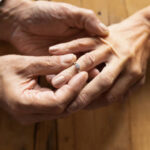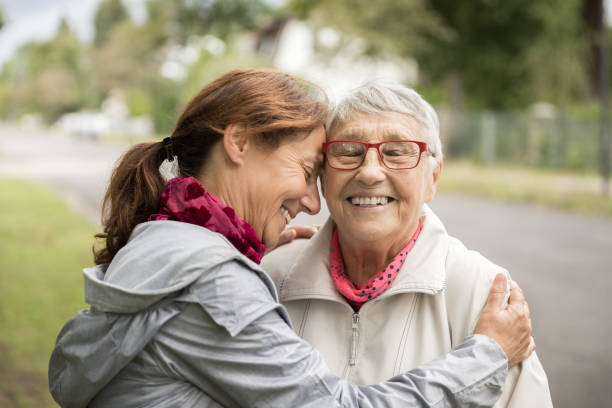For my second article in the series on seniors with an inspiring journey, I have chosen to interview my friend Linda, a resilient 63-year-old woman who is dealing with aging and a mental health disorder at the same time.
I met Linda when I was not working and I had created a personal blog on mental health. Linda had started to get interested in my articles and it’s in this context that we started online correspondence on facebook. So we decided to meet and go on small outings like going to restaurants. With Linda, I can talk about mental health and even details about psychosis without taboos. We help and support each other morally when facing challenges and difficulties. We also discuss about tools to help us recover.
In this article, I will talk about the journey of Linda through the twists and turns of mental illness. I will talk about her love life, her jobs, her volunteering and her evolution over time and what she is proud of. I will also talk about her routine, her friends and her health.
The twists and turns of mental illiness
At the beginning of the illiness, Linda would have a psychosis every year. She would be hospitalized for a day or two and they would send her home with a prescription. She was psychotic at home and she lived in hell. At her third psychosis she was diagnosed with bipolar disorder what would evolve later in a schizoaffective disorder.

Each time that she would have a psychosis, Linda would relive her first psychosis, which meant that she thought her partner at the time was in danger. When she is having her psychosis, Linda tends to ruminate which prevents her from sleeping. She has the impression of being listened and that the television is sending her messages.
Linda describes mental illness in this way: “It’ like a whirlwind, a roller coaster, you go up, you go down, it’s not a straight line.” Finally, Linda spent half of her life at the hospital.
Even if, at first glance, the psychosis can be seen as failures, Linda believes that the psychoses contributed to the person she is today. Having psychosis, she can better understand the people that suffer: “The fact that I’ve been through this helps me be more empathetic with others.”
Her love life
Linda started dating a man at 14 and married him at 20. When she left him after 3 years, she was having a hard time with her loneliness and she was looking to replace him.
It`s at that time that she met a partner who was using drugs and she started using them until her diagnosis. It was a codependent relationship (when you depend on the approval of someone else to feel good): “He was a person with whom I lived a passion, he was my drug”. One day, this partner was arrested and put in jail for 6 months. Linda would go to visit him and it was in this difficult context that she had her first psychosis and when her life was turned upside down. Then, after seven years, she had enough of this relationship, and she left him. She went to a women’s shelter because her ex-partner would abuse her verbally and would put her down to lift himself up.
Afterwards, Linda was in a couple for 3 years with a third partner. It was less of a romantic relationship than with the other partners. This relation was also toxic, and why Linda returned to a women’s shelter when she separated. According to Linda, a woman who underestimates herself and who is not self-confident can attract controlling and manipulative men.
Eventually, Linda met R, who became her 2nd husband and with whom she is still in a relationship today. R has been Linda’s husband for 30 years. “He’s the person who has shown me the most love and been the most present for me. When I was hospitalized, he came to see me every day. I could be hateful, he knew it wasn’t me, that it was my illness and that I was going through a difficult time.”

“I could be up at impossible hours doing things on the computer or I would buy things that I didn’t really need. He never said anything.”
“He always supported me in everything. When I told him that I wanted to be a peer support worker, he was behind me, he would encourage me to achieve my goals.”
To this day, R lives in a CHSLD because he suffers from Alzheimer’s disease. Linda misses his presence a lot. She calls him every day. Their conversations are not long, but just hearing her husband say I love you does a lot of good. “I am very grateful that he remembers me. It could be worse.”
Linda finds it very difficult to be away from her husband because they have known each other for 30 years. “I feel that I could not live with anybody else because love the love is still there on both sides. R will always have an important place in my life even if later on I meet someone else.”
The Mourning of Motherhood
Even if she had a desire to have children when she was with her second partner, Linda made the choice to not have any. Considering that she was hospitalized on a regular basis, she felt that this was not a conducive environment for a child. Mourning of motherhood was one of the hardest things she went through in her life because she dreamed of starting a family. Linda also says she is available for her nieces, whom she considers her daughters.
Her jobs
With regards to work, Linda considers herself lucky because she always gravitated towards places where she wanted to work. For example, she worked in mental health for an ADMD helpline (now called Relief) as a facilitator-coordinator of a mental health journal. She also worked as a secretary for an organization called Echange de services pour ainés as well as Projet Arc, a mental health community organization. She worked as a programming assistant for Equipe Entreprise. Linda retired in 2011 and she has been volunteering ever since.
Despite the roller coaster of mental illness, Linda has managed to carve out a place for herself professionally, without the help of counsellors: “In my time, there was no help from counsellors to find a job. We were left by ourselves and we were told that our mental illness was inevitable.”

Volunteering
Currently, volunteering is an important part of Linda’s life.
First, Linda makes friendship visits to the CHSLD near her home. She enjoys connecting with seniors. Not only does it bring something to them, but the seniors also, through their experiences, bring something to her. When she makes friendship visits, Linda feels like a job well done and she feels appreciated.

“I have patience with the elderly. When they tell me their stories, I find myself finishing their sentences because I heard them many times.”
Linda deplores the fact that the elderly in CHSLD are often left to fend for themselves and she sometimes realizes that for some of them, she is their only visitor.
Secondly, Linda is a peer support volunteer for an elderly lady that goes to the Douglas Institute. When she is a peer support volunteer, Linda realizes that the person has the answers to all her questions. Linda therefore acts like a guide to help the person find answers. As a peer support volunteer, she participates in the evolution of the person and she develops a wonderful bond. Even if there are no changes, she remains hopeful and she meets the person where she is at the present moment.
Finally, Linda is also volunteering with someone she has been calling since the pandemic through the organization Les petits freres. Soon, she will meet the person for the first time.
Her evolution
Linda has long struggled to assert herself; she felt obliged to answer yes. However, with the years, she learned to say no and to think more of herself. She finds that she is less affected by the opinion of others: “If they are not happy, so be it.”
Linda used to be surrounded by toxic partners, but now she feels surrounded by people who are more positive. With the years, she learned how to make peace with her past and she does not think anymore about negative things that have happened in her life. She lives more in the present moment and she learned to let go of things she can’t control.
What she is proud of
Linda is proud of having successfully completed the peer support training course of the AQRP (Association québécoise pour la réadaptation psychosociale): “I am very happy, my certificate is posted in my apartment. It’s a great achievement.”

However what Linda is the most proud of is the person she has become. With everything she has gone through, she could have given up, but she’s been resilient and bounced back every time. She never gave up hope. She is grateful for what she has. “I have a roof over my head, I have a full freezer that comes from the food bank.” Linda is also a person that wants to improve herself, she likes to learn and sign up for classes, she is curious.
Sa routine
Every day, Linda does progressive relaxation, which replaces an ativan. In the evening, before going to bed, she does guided meditation called Headspace. She also does breathing exercises.
“Before, the panic attacks used to be a problem. I was like a clockwork, every Sunday I had a panic attack. The panic attack could last 30 minutes or more. During this time, we experience discomfort, we feel like we are going to die because it is so strong. Now, with my tools like breathing exercises, I have fewer panic attacks and manage them better.”
In terms of her routine, on Mondays every two weeks, the person who does her cleaning comes to her house. It was her social worker who found this housekeeper. In fact, it’s her social worker that helps a lot with her administrative procedures. Sometimes, she sees her every other Monday. On Tuesdays, she visits the lady at the Douglas Institute as part of her volunteer work. On Wednesdays, Linda participates in an online AQRP support group. Sometimes, on Wednesdays or Thursdays, she sees her psychologist. On Fridays or on Saturdays (every two weeks), are the days she visits her husband at the CHSLD. Going to see him does Linda and her husband a world of good. Finally, on Sundays, she makes friendship visits to the CHSLD near her home.
On the other hand, Linda watches less TV than she used to. She likes to walk and enrolling in trainings such as apprivoiser sa solitude et l’intervention axée sur les forces. Overall, Linda is satisfied with her routine. She plans to read more and get out of her house a little more, including planning outings with her friends.
Her friends
When she went through psychosis, Linda had difficulty maintaining certain friendships. Nevertheless, over time, she built a network of friends of different age groups: the niece of a lady who lived at the CHSLD, a friend that she met at the AQRP, myself, a former neighbor that lives in RPA and a person that she met through the organization Les petits freres.
Linda is often the first to call and take initiative with her friends. She is satisfied with her friendships, although she would like to see her friends more often and she would like to expand her circle of friends.

Her health
Physically, Linda has cervical arthritis. Also, she feels tired because of the medication she’s taking. She sleeps an average of 11 hours a night and has difficulty getting out of bed.
Psychologically, Linda’s mental health is going well as she is stabilized now. She has the support of health professionals and uses crisis lines when needed.
Cognitively, Linda does not read as much as she would want because of a deficit in short term memory. She reads but she forgets what she read; she does not retain the information well.
Why do I think Linda is an inspiring senior?
Linda is an inspiring senior because she is coping with her mental health disorder and aging in a beautiful way. She accepts her schizoaffective disorder; she has also set up a routine to regulate her mental health. She also accepts getting older because “everyone goes through it”. Linda had to use her creativity to build her life because she did not know anybody that had the same mental health problem like hers. She didn’t have a role model.
Despite the pitfalls of mental illness, Linda fulfilled herself professionally and today it is through volunteering. Having had several psychoses, she better understands the suffering of people which is reflected in her volunteering and with her friends.
Even though she has been around toxic partners, Linda is now in a healthy relationship with R, and has been for several years. She is dedicated to her role as a caregiver to her husband.
It is inspiring to see that Linda has strength within herself that pushes her to remain hopeful despite the many psychoses she has experienced. Her training as a peer support worker helps her cultivate this hope for herself and others.
Linda: a significant person in my life
Linda is a significant person in my life. We became friends when I needed to connect with people who were living with mental health issues. Linda encourages me in my projects and helps me find the tools that support recovery. She has this motherly side, gentle, empathetic and non-judgmental; which makes me feel good when I am going through difficulties, for example my father’s health problems at the moment. As far as I am concerned, I am also an attentive ear when Linda is going through difficult situations, like for example the fact that her husband is placed in a CHSLD. To me, Linda is a model of resilience to the power of a thousand.

J’ai relu ton texte et je suis d’accord avec les changements apportés.
Bravo Prunelle! Je suis fière du resultat et d’être ton amie. C’est un bel hommage… Peux-tu partaget les commentaires si ce n ‘est pas trop personnel? Je suis curieuse de savoir comment ton article est reçu. Bonne soirée chère amie xx
Chère Prunelle, je me reconnais dans ta pratique de ´donner à la suivante’ ! Lire ton récit magnifiquement écrit sur ton accompagnement sororal de Linda me fait du bien. Soeurs en rétablissement dans tous les rebondissements de vos vies se recoupant.
Il y a quelques mois, une amie TS m’a présenté son père, jeune ivoirien de 64 ans, sévèrement atteint de Parkinson. – Moi maintenant débarrassé de ce diagnostic…- On devient petit à petit des amis en marchant ensemble tous les mardis. En se racontant…
Je me souviens de ma blonde et tous ces voisins.es qui m’ont fait marcher dans ma torpeur d’alors… Je les rencontre parfois en marchant dans le parc avec mon nouvel ami. Fier de le présenter!